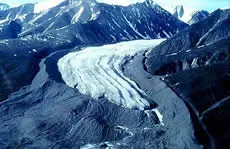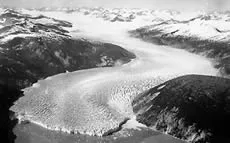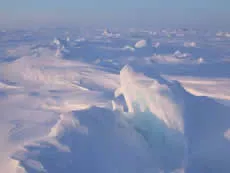Cryosphere glossary
a palsa in which the frozen core extends below the peat into underlying mineral material.
Also known as tundra mires, generally described as an area of wet, soggy, muddy ground., and often feature a layer of peat over permafrost.
precipitation consisting of a mixture of rain and wet snow; it usually occurs when the temperature of the air layer near the ground is slightly above freezing; the British term for this mixture is sleet (which has a different meaning in the United States).
a mound, ridge, or other distinct accumulation of glacial till.
Image

Lateral and terminal moraines of a valley glacier, Bylot Island, Canada. The glacier formed a massive sharp-crested lateral moraine at the maximum of its expansion during the Little Ice Age. The more rounded terminal moraine at the front consists of medial moraines that were created by the junction of tributary glaciers upstream.
Natural Resources Canada, copyright Terrain Sciences Division, Geological Survey of Canada
a nearly vertical channel in ice that is formed by flowing water; usually found after a relatively flat section of glacier in a region of transverse crevasses; also called a pothole.
a glacier that is confined by surrounding mountain terrain; also called an alpine glacier.
Image

Taku Glacier winds through the mountains of southeastern Alaska, calving small icebergs into Taku Inlet. This photograph dates from 1929.
U. S. Navy, archived at the World Data Center for Glaciology, Boulder, CO
a type of mass movement associated with shear failure in unfrozen sediments underlying permafrost, leading to detachment of blocks of frozen ground that move downslope.
ice that has survived at least one melt season; it is typically 2 to 4 meters (6.6 to 13.1 feet) thick and thickens as more ice grows on its underside.
Image

Multiyear ice.
Ted Maksym, United States Naval Academy
a geyser; a fountain that develops when water from a conduit is forced up to the surface of a glacier.
the difference between accumulation and ablation; usually expressed in terms of volumes of water equivalent per unit area.
difference between the downward and upward terrestrial radiation fluxes; net flux of terrestrial radiation.
(1) young, granular snow that has been partially melted, refrozen and compacted; névé that survives a full season is called firn; firn becomes glacial ice; (2) also refers to the accumulation zone of a glacier.